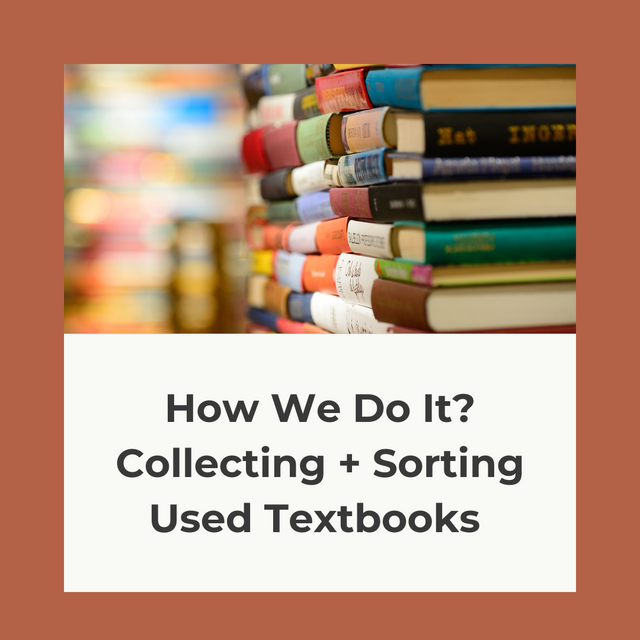How We Do It? Collecting and Sorting Used Textbooks
The Vital Process of Sorting, Collecting, and Organizing Used Textbooks in Our Circular Book Company
In the heart of our circular book company lies a meticulous and carefully orchestrated process aimed at breathing new life into used textbooks. This process involves several critical stages, including sorting, collecting, and organizing these educational treasures. By ensuring no book is wasted, our company not only promotes sustainability but also supports a network of partnerships with publishers, secondary market resellers, college libraries, bookstores, and recycling partners. This article will delve into the detailed process that drives our mission and highlight the lasting benefits to our partners and the broader community.
Introduction
At our circular book company, the journey of each textbook begins with a commitment to sustainability and a love for preserving knowledge. The intricate process of sorting, collecting, and organizing used textbooks is at the core of our operations. This labor-intensive endeavor not only saves books from landfills but also facilitates a network of partnerships that extend the life and reach of these educational resources.
The Collection Process
Gathering Used Textbooks
The collection process starts with gathering used textbooks from various sources. This includes donations from individuals, institutions, and organizations, as well as collections from schools, libraries, and bookstores. Each book is carefully tracked and documented to ensure an efficient and transparent flow of materials.
Transportation and Logistics
Transportation plays a crucial role in our collection process. We have established a robust logistics network to facilitate the movement of books from collection points to our warehouse. Our transportation partners are essential in ensuring that books are handled with care and delivered promptly, minimizing any potential damage during transit.
The Warehouse: A Hub of Activity
Storage and Unpacking
Upon arrival at our warehouse, the books are stored in a designated area where they are unpacked and prepared for the next stage. Our storage facilities are designed to protect the books from environmental damage, ensuring they remain in the best possible condition.
Sorting and Grading
The sorting process is both meticulous and methodical. Each book is carefully examined and graded based on its condition. Books are sorted into categories such as like-new, used, and those requiring repair. This grading system helps streamline the next steps in our process, ensuring that each book receives the appropriate level of attention and care.
Repair and Restoration
Books that require repair are sent to our repair team. Skilled technicians work diligently to fix bindings, replace covers, and mend any damaged pages. This "labor of love" ensures that books are restored to a condition suitable for reselling, preserving their educational value.
Partnerships and Their Benefits
Collaborations with Book Publishers
Our partnerships with book publishers are mutually beneficial. By redirecting used textbooks back into circulation, we help publishers reduce the environmental impact of producing new books. In return, publishers support our efforts by providing resources and expertise, enhancing the quality of our restoration processes.
Supporting Secondary Market Resellers
Secondary market resellers, such as online bookshops and brick-and-mortar stores, benefit from our supply of high-quality used textbooks. These partnerships provide resellers with a steady stream of inventory, allowing them to offer affordable options to their customers. This collaboration helps promote a culture of reuse and sustainability in the book market.
Engagement with College Libraries and Bookstores
College libraries and bookstores play a vital role in our network. By supplying our team with their used or damaged books we help create a new stream of revenue and also help students with access to affordable educational materials. This support is crucial in fostering academic success and promoting literacy.
Recycling Partners for Books Beyond Repair
Books that are beyond repair are not discarded but are instead redirected to our recycling partners. Together we specialize in upcycling materials into new products, such as recycled paper products. This ensures that even the most damaged books contribute to a sustainable cycle of reuse.
The Labor of Love in Preserving Textbooks
Commitment to Zero Waste
At the heart of our operations is a deep commitment to ensuring no book goes to waste. Every book, regardless of its initial condition, is given the opportunity for a second life. This dedication to zero waste is a testament to our belief in the enduring value of printed materials.
Preserving Knowledge for Future Generations
Our efforts in preserving textbooks go beyond environmental benefits. Each book we save represents a piece of knowledge that can be passed on to future generations. By keeping these books in circulation, we contribute to the ongoing dissemination of information and learning.
Fostering a Culture of Sustainability
The work we do is not just about preserving books; it's about fostering a culture of sustainability. By demonstrating the value of reuse and repair, we inspire others to adopt similar practices in their own lives and businesses. This cultural shift is essential in creating a more sustainable and environmentally conscious society.
Conclusion
The process of sorting, collecting, and organizing used textbooks in our circular book company is a comprehensive and labor-intensive endeavor. From transportation and storage to sorting, grading, and repair, each step is meticulously planned and executed. Our partnerships with publishers, resellers, libraries, bookstores, and recycling partners are integral to our success, providing mutual benefits that extend the life of books and promote sustainability. This labor of love ensures that no book is wasted and that knowledge is preserved for future generations.

